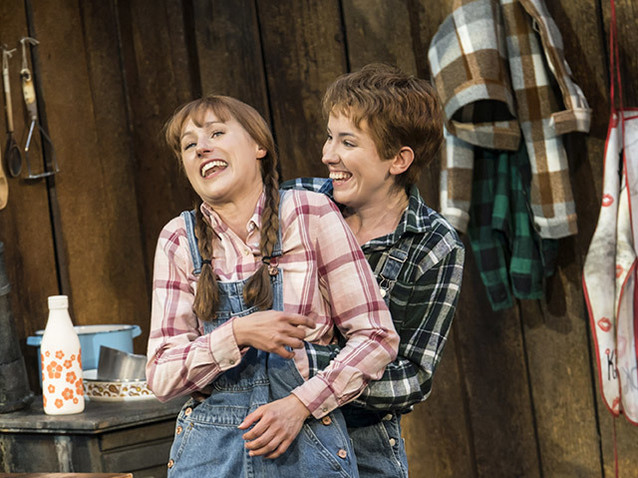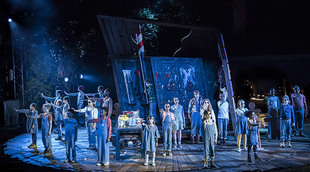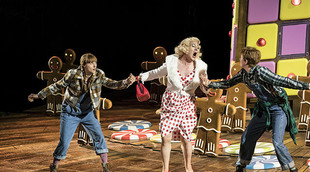 © (c) Johan Persson
© (c) Johan Persson
Engelbert Humperdinck’s Hansel and Gretel, which premiered in 1893, is based on the eponymous fairytale that was recorded by the Brothers Grimm and published in 1812. It follows the Grimm version of the story reasonably closely, although there are a few notable differences including the fact that the Mother here is not intent on losing the children in the forest so that she and her husband might survive the hard times. She sends them out to collect berries as a punishment for misbehaving, and because she needs the food, but is as horrified as anyone when she realises that a Witch lives there who could entice and eat them.
This is the second year in which English National Opera has presented a production at Regent’s Park Open Air Theatre, following Britten’s The Turn of the Screw in 2018. Director Timothy Sheader has come up with a highly inventive concept that perfectly complements the idea of enjoying a (hopefully) warm summer’s evening in the outdoors. In Peter McKintosh’s set, Hansel and Gretel’s cottage stands at the centre of the circular stage in Act I, while in Act III it is substituted for the Witch’s gingerbread house. During the Prelude we see other children being tempted away from their own parents by sweets given out by a band of zombie-like figures who are presumably the Witch’s previous victims, and are now prowling for others to join their number. It may be a disadvantage to see Hansel and Gretel already gorging on sweets when in the original they are gathering berries, as it undermines the impact of what they see when the gingerbread house finally appears, but this a small point compared with the overall slickness of the execution.
Hansel and Gretel’s cottage looks quite traditional, but it does enjoy a sink with running water, while brands such as Heinz baked beans feature among the goods that the Father brings home. When the scene transitions from the home in Act I to the forest of Act II the zombie-like figures place their broomsticks in the stage to create its trees. The episode inside the gingerbread house is also very colourful as the Witch even uses the copious amounts of cream that it contains to shave her legs, while the evening is planned to start at 8.00pm so that this final encounter can take place in the dark.
The greatest innovation, however, comes in the Traumpantomime that ends Act II. This normally sees fourteen angels gather around Hansel and Gretel to protect them as they sleep, but the routine opted for here, courtesy of movement director Lizzi Gee, feels both appropriate and entertaining as a series of flight attendants process on. In this way, they silently act out all of the safety instructions and serve the children their meals as if they are flying them to the land of dreams.
Inevitably, given that this is an open air venue, everything is amplified, and while last year with The Turn of the Screw this helped Britten’s score to carry a ghostly tinge, it is harder to detect such a compensatory factor here. Nevertheless, the quality of the amplification is extremely good, while Derek J Clark’s reduced orchestration, here conducted by Ben Glassberg, comes across very well.
Two casts perform over the run, with Cast A being led by Rachel Kelly as Hansel and Susanna Hurrell as Gretel. Both display highly pleasing voices while Kelly has clearly observed the mannerisms of a 10-year old boy well, and Hurrell tempers Gretel’s sense of responsibility with her own child-like exuberance. Rosie Aldridge displays an excellent mezzo-soprano and appropriate exasperation as the Mother, while Duncan Rock booms to magnificent effect as the more happy-go-lucky Father. Gillian Keith and He Wu excel in the small roles of the Sandman and Dew Fairy respectively, with Keith even sitting among the audience for the whole of the first half so that she can rise unexpectedly when the character appears.
Finally, Alasdair Elliott, with his excellent and powerful tenor, really goes to town as the Witch, which is a part that can be played by either a man or a woman. There are many ways to portray the character as sweet and respectable before she reveals her true colours, but never before perhaps have we been offered a Witch who seems quite so much like a well-to-do middle-aged lady with a plethora of airs and graces.
By Sam Smith
Hansel and Gretel | 14 – 22 June 2019 | Regent’s Park Open Air Theatre, London
the 22 of June, 2019 | Print


Comments